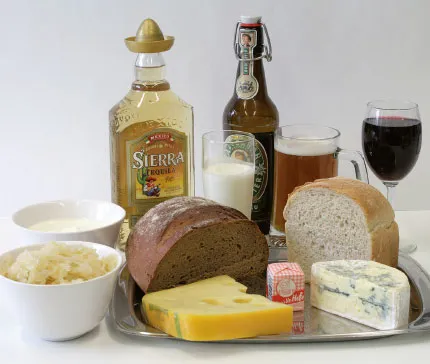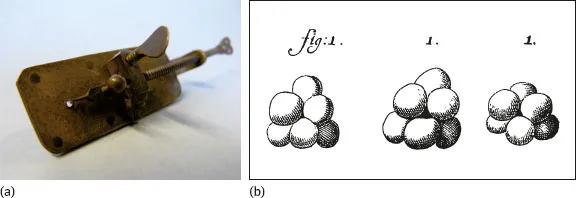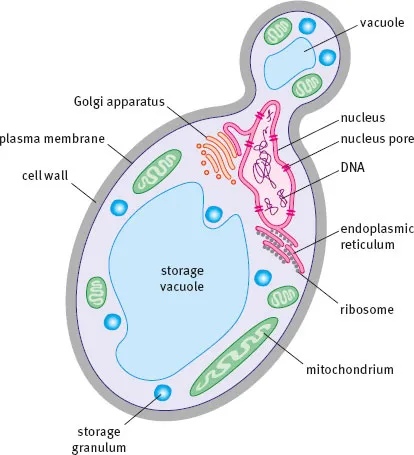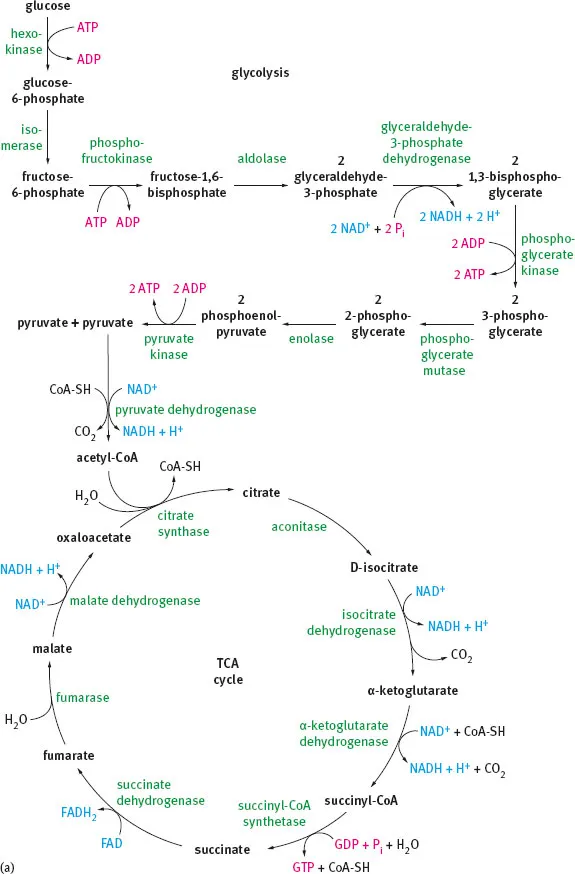![]()
Nicole Frankenberg-Dinkel
1History of biotechnology and classical applications in food biotechnology
Biotechnology is defined as the use of biological processes, organisms, or systems to manufacture products intended to improve the quality of human life. Derived from the greek word βíoς (bios-life) and combined with the word technology, it represents an interdisciplinary science which employs enzymes, cells or whole organisms for technical use. Biotechnology combines knowledge from a wide variety of disciplines including microbiology, biochemistry, genetics, bioinformatics but also process technology and chemical engineering.
1.1History of food biotechnology (a brief overview)
Biotechnology is not new. Very early examples date back 10,000 years and include in a very broad-ranging definition the domestication of animals, the planting of crops and the use of microorganisms to produce alcoholic beverages (wine, beer), dairy products (yoghurt, cheese), bread but also Sauerkraut and silage (Figure 1.1). Dogs, sheep and cows were among the first domesticated animals and used for meat and milk production. For plants, rice, wheat, and barley are thought to be the first crops to be farmed to obtain a reliable source of food. The main purpose to employ fermenting microorganisms was to preserve and refine food. The most relevant organisms in these processes even until to date are yeasts and lactic acid bacteria.
Fig. 1.1: Various food products made with the help of microorganisms. Most of the product displayed are produced by the action of yeasts and/or lactic acid bacteria.
1.1.1Bread-baking in ancient Egypt
Bread and beer was central to the ancient Egyptian diet and consumed with every meal. Early descriptions, mainly from artistic scenes, date back 4000 years BC. Bread was mainly made from emmer wheat (Triticum dicoccum) and in the early days only sometimes included yeast for leavening the dough.
1.1.2Ancient beer brewing
Several recipes for beer have been derived from inscriptions. One includes the use of a yeasty bread (“beer bread”), which was lightly baked and crumbled into water. Dates were added for flavor and the mixture was fermented in a tub before it was sieved and filled into jars for storage. However, there is also evidence for brewing beer from barley and emmer wheat by heating and subsequent mixing with yeast. The existence of yeast was not yet known to the brewer but based on experience they knew that the addition of the sediment from a well-done beer enhanced the fermentation effect. Traditionally, beer brewing in ancient Egypt was a female activity.
The Celts and Teutons preferred a slightly acidic beer (mead) which they stored in large jars underground to keep the temperature low. Honey was added for sweetness and flavor. Much later, in the 6th century, monks developed a more sophisticated method for brewing beer. Still until nowadays the “monastery beers” are known for their richness and high alcohol content and served the monks as a nutritious drink during Lenten season.
1.1.3Winemaking (vinification)
Like for beer brewing there is also evidence for ancient winemaking not only on the European continent but also in Asia (China). Traditionally, wine was made by fermenting grape juice employing yeasts which were already present on the grape skin. These natural yeasts can be used for the primary fermentation, which converts the sugars of the grape juice into alcohol (details see 1.3). However, in order to avoid unpredicted results from natural yeast variations on the grapes, addition of cultured yeasts in nowadays winemaking is a must. Some wines require a secondary, malolactic fermentation in order to obtain a softer taste. Malic acid which is mostly present in red wine must has a tart-like taste and is converted by certain strains of lactic acid bacteria to lactic acid which has a more softer taste (see also 1.5.6 of this chapter).
Fig. 1.2: Early microscopy. (a) Replica of a Leeuwenhoek microscope from Museum Boerhaave Leiden (photograph courtesy of medizinhistorische Sammlung Ruhr University Bochum). (b) Yeast (nl. “gist”) as drawn schematically by Antonie van Leeuwenhoek in his letter to Thomas Gale of June 14th 1680, pp. 6–10.
1.1.4The first description of bacteria and yeast
It was not until the 17th century that the Dutch merchant Antonie van Leeuwenhoek (1632–1723) observed the first bacteria and yeast, which he investigated with his home-made microscope. This first microscope had a single glass lens with a magnification of about 200-fold (Figure 1.2) which enabled van Leeuwenhoek to observe yeast and bacteria at the cellular level. Although yeast was already used in concentrated and enriched form for bead baking, beer brewing, and winemaking, it was still unknown that it was a living creature. Due to van Leeuwenhoek’s keen interest in nature, he was inspired to investigate sheep hair, water droplets from a rain barrel but also beer samples with his microscope, which resulted in numerous drawings. He was the first to draw images of bacteria and yeasts in their morphologic diverse from (Figure 1.2) which he later sent to the Royal Society in London. Although van Leeuwenhoek never attended a University, he was elected to the Royal Society in 1680 due to the discovery of his “little animals”.
1.2A work horse of food biotechnology: Yeast
Microorganisms can be divided in eukaryotic (greek: karyon, nucleus) and prokaryotic ones. While eukaryotic microorganisms have a complex cell architecture, prokaryotes are rather simple. The yeast Saccharomyces cerevisiae (baker’s yeast) is a eukaryotic model organism (see also chapter 4). It belongs to the fungi, specifically to the group of Ascomycetes. This class is characterized by typical sporangia, called asci (singular ascus), which are generated during the sexual life cycle. Like all other eukaryotes its cell structure is complex including compartmentalization (nucleus, mitochondria, Golgi apparatus etc.) (Figure 1.3). Yeast consists of only a single cell which propagates by budding and each daughter cell itself can give rise to new cells (Herskowitz 1988). This asexual propagation involves mitosis and results in the duplication of a haploid or diploid genome that is then evenly distributed among mother and daughter cells. In nature, S. cerevisiae exists in the diploid state. Under certain growth conditions (e.g. nitrogen starvation), yeast cells are able to undergo a life cycle with meiotic divisions, which result in the generation of asci with four haploid ascospores that carry one of the mating type loci (“alpha” or “a”). In the laboratory, these haploid cells can be separated to receive haploid strains, while in nature two haploid strains of the opposite mating type will immediately fuse after germination to generate diploid strains. This life cycle of fungal yeast is known as the sexual life cycle. In biotechnological applications however, the asexual cycle is of major importance. Notably, in some applications, e.g. during breeding of brewer’s yeasts, the sexual life cycle is used to generate recombinant strains with newly acquired properties.
Fig. 1.3: Schematic drawing of a yeast cell.
Fig. 1.4: The central metabolic pathways for glucose utilization in yeast. (a) Glucose is first oxidized during glycolysis to the central metabolite pyruvate which is decarboxylated to acetyl-CoA. During the following citric acid (TCA cycle), acetyl-CoA is fully oxidized and the generated reducing equivalent shunt into the electron transport chain. (b) In a series of redox-reactions electrons are transported to the final oxidase which reduces oxygen. The concomitantly transported protons generate a proton gradient across the inner mitochondrial membrane which is used by ATP synthase to generate ATP. Glycolysis takes place in the cytoplasm of the yeast cell, pyruvate is subsequently transported into the mitochondrial matrix. The final electron transport chain is located in the inner mitochondrial membrane.
Yeasts grow heterotrophically, meaning they require an external carbon source (glucose, maltose, trehalose) with the central metabolic pathways in action (glycolysis, citric acid cycle (TCA cycle; Krebs cycle) and oxidative phosphorylation) under aerobic conditions. As yeast is a facultative anaerobe, it can also grow under fermenting conditions. The biotechnological use mainly relies on the metabolic pathways being active under anaerobic conditions. Here, yeast ferments the sugar to alcohol (ethanol) and carbon dioxide, a process that takes place in the cytosol of the cell.
1.2.1Glycolysis
During glycolysis, a series of reactions transform glucose into pyruvate with the formation of two molecules of adenosine triphosphate (ATP) and the reducing equivalents nicotinamide adenine dinucleotide (NADH). Glycolysis is operative under oxic and anoxic conditions and starts with the activation of glucose by two molecules of ATP and a subsequent isomerization. The resulting fructose 1,6-bis-phosphate is cleaved by aldolase to yield the triosephosphate isomers dihydroxy-acetone phosphate and glyceraldehyde-3-phosphate. Energy extraction occurs through substrate level phosphorylation in two reactions. First, phosphoglycerate kinase converts 1,3-bisphosphoglycerate to 3-phosphoglycerate under the generation of ATP. The second reaction is the final step of glycolysis where phosphoenolpyruvate is transformed to pyruvate by pyruvate kinase (Figure 1.4). All glycolytic enzymes are located ...





